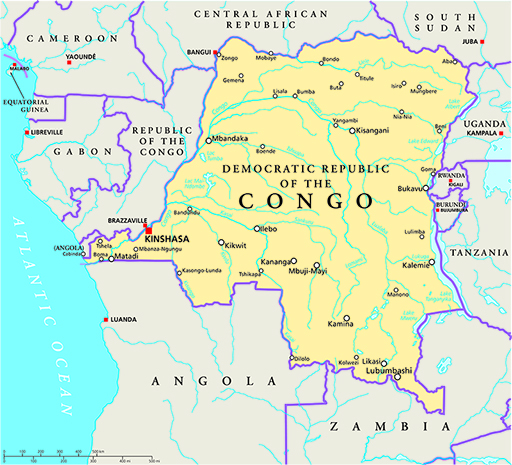3 Further examples of specialist terminology
There are many kinds of songs that contain elements beyond those designated by terms such as ‘verse’ and ‘chorus’, as you will discover in the following discussion of Congolese rumba. Congolese rumba is a form of dance music popular in the Democratic Republic of Congo (the DROC; see Figure 3). It shares its name with an Afro-Cuban genre of music and dance and emerged in the wake of the global circulation of recordings of Afro-Cuban rumba (White, 2002; 2008). However, Congolese rumba is distinct in many ways from its Cuban namesake.
Congolese rumba songs have many elements in common with the US pop music you considered in the earlier sections; for example, many rumba songs have structural divisions similar to verses and choruses (White, 2008, pp. 54–5). At the same time, Congolese rumba has since the 1970s employed a distinctive formal element with its own specialist term: the seben. Songs that incorporate the seben typically begin with sections similar to, if not exactly like, the verses and choruses discussed earlier. But when the seben arrives, a few minutes into the song, the music changes, often becoming faster and almost always more danceable. The seben continues until the end of the song, frequently lasting longer than the preceding sections combined.
The seben typically incorporates exhortations to dance and calls out to existing or potential financial sponsors (it is often necessary to have the support of wealthy patrons in order to make a living as a musician in the DROC) (White, 2008, p. 171). These are spoken or sung by an atalaku, a vocalist who takes over from the lead singer during this part of the song (White, 2008). In addition to the atalaku, the seben typically features soaring guitar melodies and a repeated rhythm closely associated with the style (you will revisit this rhythm in a later course in this series).
Activity 3 Listening to ‘Perdu de vue (Aguisha)’
The song in Audio 3 [Tip: hold Ctrl and click a link to open it in a new tab. (Hide tip)] is ‘Perdu de vue (Aguisha)’ by Papa Wemba and Viva la Musica, a well-known Congolese ensemble. As Table 3 below shows, the song consists of three distinct sections. The start time for the first two sections is given.
Read the descriptions of the sections in the ‘Notes’ column of Table 3 and then try to determine when the third section of the song, the seben, begins. Enter the track time in the text box provided in the table.
| Part of song | Track time | Notes |
| First section | 00:00 | The lead singer (Papa Wemba) is heard prominently during this part of the song, which is sedate in comparison to later ones. |
| Second section | 01:21 | The rhythm changes at the beginning of this section, which is more animated than the preceding one. We still hear the lead singer, but he now sings in alternation with a group of backing singers, who take on a more prominent role as the section progresses. |
| Seben | The rhythm changes significantly at the beginning of this section, which is more animated still than the preceding one. There are prominent guitar melodies, and new vocalists take over, typically speaking but occasionally singing. |
Comment
The seben begins at 02:49. You should have been able to perceive the start of it. If not, listen to the recording a few more times, keeping an eye on the track time and listening for the changes identified in Table 3 above.

